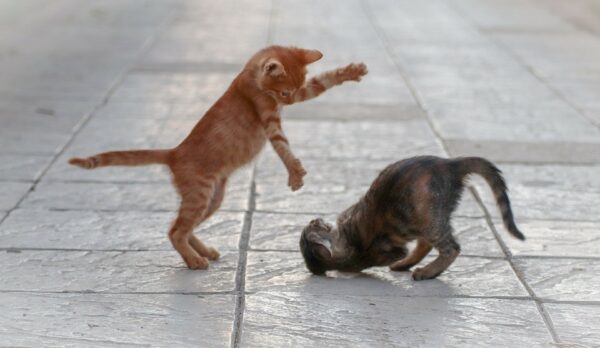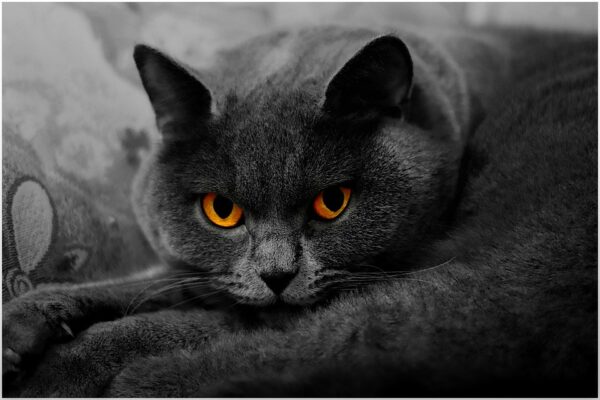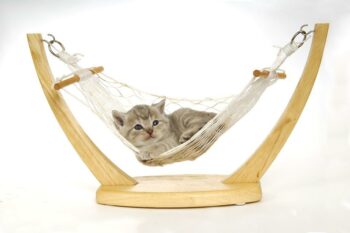Greetings and happy purrs today from Lucinda, your literate cat. This post will be a bit different. My CCL (Cantankerous Cat Lady) showed me an article in the Catster online magazine about the difference in the way a cat and a two-legged age.
After reading this article, I learned some answers to some things that puzzled me. How did two-leggeds get so old? Why did it take them so long to grow up?
It all has to do with speed. We cats race through our days. Because we do so, we have to learn things very quickly, as we don’t have as much time to do our learning as the two-leggeds. They, on the other hand, grow and mature very slowly. Thus we develop in very different ways.
Let’s consider some examples. We grow and develop the fastest in our very early days of life. The space of time you measure as a year is actually measured as 15 years in that same time period for us.

In that first year, by your reckoning, our mother educates us in all the ways of the cat. Compared to you two-leggeds, we could be considered “precocious” (a new word I just learned) because we walk at about six weeks old. You two-leggeds don’t learn to walk until you are at least a year old.
At first, you move on all fours, much as we do. We just continue that way, not bothering to learn to stand on two legs for long periods of time.
You have a period you call the “terrible twos” when your infant reaches two years old. We go through this “terrible” period about the time we are learning to walk. In a cat household there are usually several siblings, and our mother finds it hard to keep us all in line for a while.
Your two-legged babies begin to eat some solid food at four to seven months. We cats can be introduced to wet cat food at about eight to ten weeks of age. Undoubtedly that”s another reason we mature so fast — we get protein so early.
During your very early years, you start to learn to talk. We are not born with the necessary physical equipment that would allow speech. Therefore, our language is composed of some sounds and a lot of silent body language.
We can tell another cat what we are thinking by a flick of our tail or a movement of our fur. We can smell danger or sickness. Why, we could serve in the military as spies because the enemy could not hear or understand our messages.
I was puzzled by the way you divide time. You consider what you call a “day” to be 24 hours. In one of those 24-hour periods, we will experience several days of cat time. You will notice that we sleep a lot. Our sleep pattern actually divides our time into “cat days,” which equals the time between our many naps.
You two-leggeds go off to school at about age six. By that time, we have already graduated and are learning about the world. In fact, after our mother no longer teaches us, we learn on our own from the College of Cat Experience.
Some of our lessons are easy, and some of them are hard, or even fatal. That’s because we come equipped with something called “curiosity.” This trait is very important to our continuing education, but sometimes it can lead to disastrous results.
Here’s another important difference: We learn about love and sex at a much younger age than you. By the end of our first year (by your measure) we might have already fallen in love a time or two, and if we are female, we may have already become pregnant from our first sexual experience.
A cat can have kittens when she is as young as six months old. Can you visualize a six-month-old two-legged having a baby? I think not.
We are perhaps lucky when it comes to sex. We don’t feel the urge to mate all the time, like some two-leggeds seem to do. That’s a very good thing. Our lives go by so fast, and if we wanted to mate all the time, we wouldn’t have time to do all the other things life has to offer.
In our second year we slow down a bit, as it is equal to about nine of your years. During this period, if we live in a home where we are allowed outside, we perfect our hunting skills. We don’t use external weapons like you do when you hunt, but have our own built-in equipment.
hunting skills. We don’t use external weapons like you do when you hunt, but have our own built-in equipment.
Again, we are fortunate that our weapons are always with us. You never know when you will need them! Think of the advantage — no heavy devices to carry with us. It allows us to perfect our hunting skills at an early age. Can you imagine a two-year-old two-legged toting a gun and hunting for dinner? No? They have to wait until they are at least a teenager to manage such a weapon.
Meanwhile, when we get to your year two, we are already a teen-aged cat. By the end of year two, we are a young adult cat, about the same age as a 24-year-old two-legged.
Now we have set attitudes and ideas about the way our world works. We start to think about territory, and stake out our own personal turf.
Now, here’s another big difference: We are not at all mechanically inclined. “Mechanical” is another idea that I had to look up. It has to do with machines, something foreign to cats. As kittens, many of us thought the things you call “cars” or “trucks” that carry you around were actually alive. Now I know better.
Sometime between age 16 and 24, you learn to drive a car, a concept very foreign to us. Can you imagine a two-year-old cat learning to drive? Or a cat of any age? It’s just not our thing. Often, because the whole car idea is so foreign to us, we are very frightened by these big contraptions, seeming to us like big boxes on wheels.
It’s probably a good thing we don’t drive. We’d probably go too fast and get in a wreck. Our first challenge would be figuring out how to reach the pedals on the floor and the thing called a steering wheel at the same time. Perhaps it would take two or three cats to run a car — a couple on the floor to push the necessary pedal parts, and one to steer.
Thank goodness we don’t have to learn these skills. We can leave it to you big creatures. You designed these things in the first place, anyway. We’ll keep our lives much simpler.
Another strange habit of adult two-leggeds is that they often shave off their facial hair. Most male two-leggeds do, and even some females. We could never do that! Our whiskers are very valuable tools to us, acting something like fingers. I know you two-leggeds would not cut off your fingers, so leave our whiskers alone!
After age 24 for cats and two for two-leggeds, things slow down quite a bit. From now until the end of days, our year equals four of yours. It probably explains why we sleep for even longer periods, and why many of us are able to adopt the two-legged pattern of sleeping all night. After a long night’s sleep, we can take shorter naps during the daylight hours and enjoy our time awake.

When we become old cats, we experience many of the same problems as some two-leggeds have. For example, my old cousin Pogo has something called arthritis, which makes many of his body parts stiff and sore. We might also experience other physical problems or illnesses.
Without you, we would suffer in silence, and either recover or perhaps die. You, on the other hand, if you share your home with us, might take us to someone called a veterinarian. This two-legged specializes in the problems of animals. Many of us cats call this two-legged the “cat torturer.”
Because such a practice is unknown to us (we do not have cat doctors), we are often frightened a great deal by the experience and thus do not realize this cat torturer is actually trying to help us. Later, we feel better, but do not credit it to that horrible visit to the vet.
There are so many ways we two species are different! I’m sure I’ve forgotten to mention some important ones. Therefore, I’m requesting that you add your own comparisons in the comments at the end of this post. I would love to read what you can contribute. Thanks for visiting and reading, and do return often.
Lucinda

